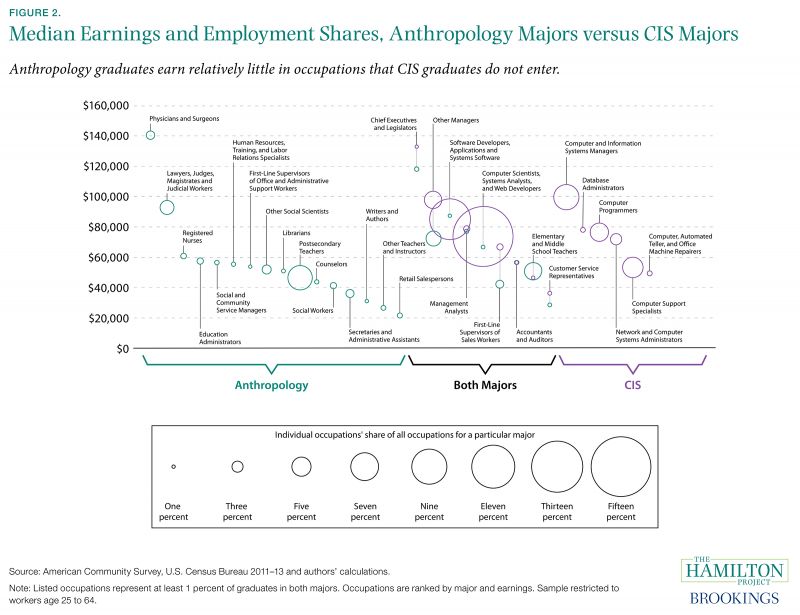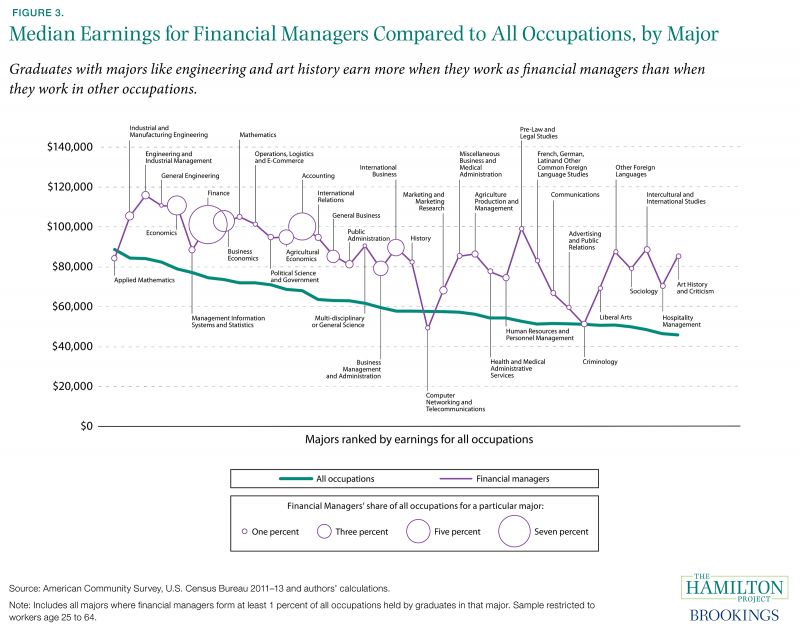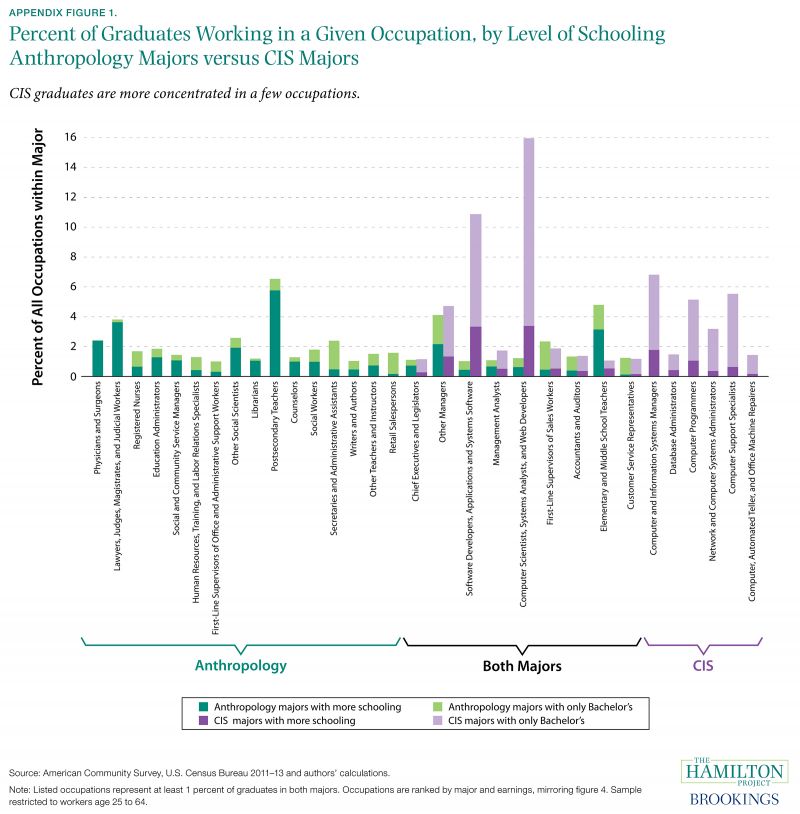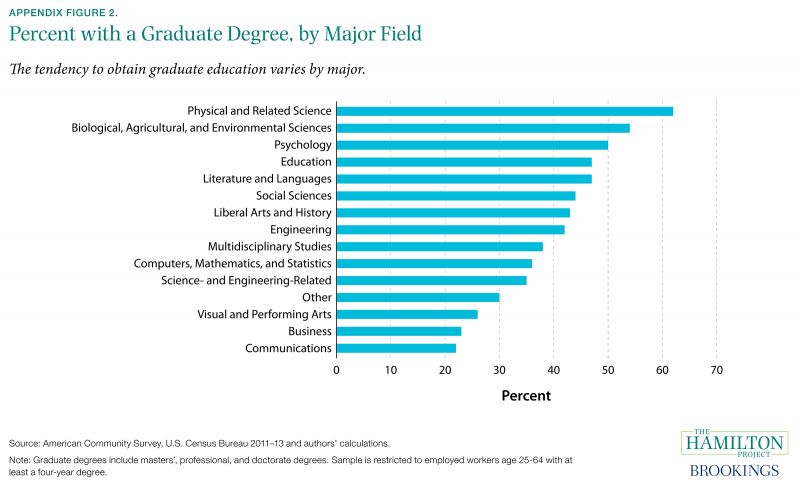For most people, a college degree is helpful for flourishing in the labor market. College graduates earn more than workers with less education—on average, about $600,000 more over their lifetimes than workers with only a high school education. College graduates also have much lower levels of unemployment, enjoy better health, and have lower mortality rates.1
However, not all college experiences have the same benefits. A previous Hamilton Project economic analysis documented important variation in earnings across college majors: for the median degree holder, cumulative lifetime earnings ranged from about $800,000 to roughly $2 million. At the high end of the earnings distribution are graduates who majored in fields emphasizing quantitative skills, such as engineering, computer science, economics, and finance. At the low end are graduates who majored in fields that emphasize working with children or providing counseling services, including early childhood education, elementary education, social work, and fine arts.
In the following economic analysis, we build on this previous Hamilton Project research and other work by examining how students’ career paths after college explain earnings variation within majors. Not only do students from the same major transition into a surprising variety of occupations, they also earn very different incomes: to take one example, the 1.2 percent of philosophy majors who enter the corporate sector and become management analysts earn a median salary of $72,000, while the 8.0 percent of their counterparts who become postsecondary teachers (e.g., professors and lecturers) earn $51,000. Different career paths and the associated earnings differences for students with the same college major are pervasive and important for understanding both the benefits of college majors and of college itself.
This tremendous diversity of career paths is interesting in its own right, but it also has practical implications for prospective students and their families. Understanding the ways that college majors and occupations interact can be useful for those students deciding on a major as well as those graduates who would like a better sense of the career paths taken by graduates with similar academic interests.
To provide college entrants and graduates, as well as career-switchers, with more information about earnings profiles and the diversity of career paths people have pursued with their major, we offer the accompanying interactive. Users can view the most common occupations for a given major, comparing earnings by occupation at different stages in the life cycle and for men and women separately.
To implement these analyses, we use the American Community Survey (ACS) 2011–2013 3-year sample, which contains information about detailed major, occupation, earnings, hours, and demographic variables. This sample is very large, at 3 percent of the U.S. population, which allows us to estimate outcomes even for relatively uncommon majors (171 in total) and occupations (217 in total).
People with the same college major often go into a wide variety of different occupations
One way to measure how likely a particular career path is for a given major is to determine what is the most common occupation associated with the major, and to estimate the fraction of graduates employed in that occupation. Figure 1 shows this variation for groupings of college majors, or fields.2
In most fields, a large majority of graduates are not working in the most common occupation in their specific major.3
The wide variation in occupations, for people with the same college major, matters for earnings. Consider a hypothetical scenario in which graduates with a particular major enter different occupations, but those occupations all pay about the same on average. In this case, variation in occupation would explain little of the wage variation within a given major. Now suppose that graduates with a particular major enter different occupations with widely varying compensation levels (e.g., some philosophy majors become teachers while others become investment bankers). In that case, disparities in earnings within major will be substantially accounted for by differences in occupation.
Indeed, differences in occupation account for a substantial fraction of variation in earnings. Within the same major, taking different career paths can explain roughly 15 to 25 percent of the variation in individual earnings. Occupations play a particularly large role in the hard sciences and in multidisciplinary fields, accounting for 22 to 25 percent of the total variation in earning.

Understanding the labor market paths of majors
To better understand graduates’ labor market paths, we use the example of the following majors, anthropology and archaeology (hereafter shortened to “anthropology”) and computer and information systems (CIS). The median anthropology graduate earns about $20,000 less than the median CIS graduate—$48,000 versus $69,000.
The difference in overall median earnings across the two majors largely can be ascribed to two factors. First, there are many high-paying occupations in which CIS graduates work that anthropology graduates do not, such as computer and information systems management, and computer programming.4 Similarly, there are a number of anthropology graduates working in relatively low-paying occupations in which CIS graduates do not, including social work, writing, and retail sales.5
Second, CIS graduates are much more likely to work in the higher-paying occupations that both majors have in common. For example, while both majors receive similar pay when they become computer scientists, systems analysts and web developers, only 1 percent of anthropology majors work in this occupation while fully 15 percent of CIS majors do. This difference is observable in figure 2, where the size of the bubbles corresponds to the particular occupation’s share of all occupations in which graduates of that major work.6
In figure 2, median earnings for each major-occupation combination is represented on the vertical axis, while the share of graduates in a given occupation is indicated by the relative size of each circle. Note that occupations with a significant share of CIS majors but not anthropology majors are on the right side of the graph, while occupations with anthropology majors but not CIS majors are on the left, and occupations that are in common between anthropology majors and CIS majors are in the middle.

Of course, obtaining a given job may sometimes require education beyond the undergraduate level, depending on the occupation’s requirements and the worker’s undergraduate major. Appendix figure 1 shows the fraction of anthropology and CIS graduates who work in a given occupation, divided into those with only a four-year degree and those with a graduate degree. Appendix figure 2 illustrates how the likelihood of receiving additional schooling varies overall by undergraduate major.
Earnings within occupation and across major
Another useful way to think about graduates’ earnings can be obtained by proceeding in the opposite direction: comparing earnings within a given occupation, by college major. One interpretation of these results is that they are informative about the comparative advantage of graduates in a particular major: where earnings are very high for a major-occupation combination relative to that same major applied to all other occupations, that major may be particularly effective preparation for the occupation.
An example of this method is depicted in figure 3. The purple line shows the earnings of financial managers by their undergraduate major, and as in Figure 2, the share of a given major that is employed as a financial manager is represented by the size of the circle. Majors in economics, finance, business economics, and accounting are more likely to become financial managers than other majors. The green line shows median earnings of all workers (i.e., not just financial managers) who graduated with those same majors. As might be expected, financial managers typically earn more than workers in other occupations, and this is reflected by the fact that the median earnings line for financial managers is almost always above the overall median earnings line. However, these earnings premiums vary substantially across majors, with the few graduates from applied mathematics, computer networking, and criminology who become financial managers earning the same or less when compared with other occupations for the major.

By contrast, the relatively few majors in engineering and industrial management, pre-law, or art history who become financial managers tend to earn much more than the same majors receive in other occupations. In each of these examples, earnings are at least $31,000 higher than overall median earnings for the major. Importantly, this does not adjust for the differing likelihood of obtaining graduate education.
Conclusion
College graduates with the same major enter a diverse array of occupations that comes with a wide range of earnings levels. The likelihood that a college graduate works in a particular occupation also varies widely by college major.
The Hamilton Project aims to contribute to the development of sound policy based on high-quality evidence, as well as to promote broad-based economic growth. Understanding the ways that college major, occupations, and earnings interact is important both for assessment of education policy and for the career decisions made by college graduates.
Appendix


We thank Lauren Bauer, Sandra Black, Brad Hershbein, Melissa Kearney, Ofer Malamud, Megan Mumford, and David Ratner for insightful comments. We also thank Kriston McIntosh and Anna Rotrosen for their extensive feedback in the development of the accompanying interactive.
1 Of course, not all of the differences in later-life outcomes for college graduates and non-graduates are ascribable to the college experience itself. These groups leave high school with abilities and social support that are already different in ways that matter for life outcomes. Still, careful research has indicated that college completion has a causal impact on earnings.
2 We focus on broad groupings of majors because the sheer number of individual majors makes them too unwieldy for visual presentation. However, the associated interactive provides information that is specific to individual majors and occupations.
3 Occupational definitions are not perfect: individuals in the same type of job may occasionally be classified in different occupations, which would tend to lower the fractions reported in figure 1. Our calculations use detailed occupations as described by 4-digit Census codes as well as detailed college majors; individuals are grouped into the more aggregated “major fields” for ease of presentation. When we instead define “most common occupation” as the group of occupations containing the worker’s reported occupation—which would be expected to reduce misclassification error—we obtained somewhat higher shares but broadly similar results.
4 Moreover, anthropology graduates are more likely to earn post-graduate degrees. Excluding customer service occupations, a greater share of anthropology graduates have additional schooling than CIS graduates, and in a majority of shared occupations, more schooling that anthropology majors overall.
5 There are many factors that could play into the patterns depicted in figures 2 and 3. Notably, worker age and graduate education; firm size, industry, and location; and unobservable worker characteristics all affect earnings and entry into occupations.
6 25 occupations for anthropology and 15 occupations for CIS reach our minimum threshold of 1 percent of all workers within a given major. As figure 2 demonstrates, there is some overlap in these occupations.




